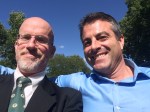Five questions with Dr. Carlin Senter, Program Chair for #AMSSM2021
March 29, 2021
CJSM is the official journal of the American Medical Society for Sports Medicine (AMSSM), and so we are especially eager for the upcoming AMSSM Annual Meeting to be taking place virtually (meaning: you can ‘touch bases’ anywhere on the planet) 13 – 18 April, 2021.
Carlin Senter, M.D. is the Director of Primary Care Sports Medicine at the University of California, San Francisco, and the Program Chair for #AMSSM2021. We can only imagine how busy she is right now, with only a few weeks left before the big event.
Somehow, she found the time to let us interview her. Thank you, Dr. Senter, and ‘see’ you in a few weeks at the meeting.
_______________________________________________________
1. CJSM: Dr. Senter, you are the Program Chair for the upcoming AMSSM 2021 meeting, to be held virtually, and we know you have been very, very busy with the preparations. What have been some of your significant challenges getting the program up and running in the middle of a pandemic? Have there been any unforeseen opportunities that a virtual meeting has offered you and the society?
Carlin Senter, M.D. (CS): Actually chairing the Program Planning Committee was a great project for me to dig into during all of the uncertainty and challenges of 2020. I really enjoy planning CME meetings and have experience doing so, so this was a fun project for me. I love the creativity involved in planning these meetings and the way you get to shape a meeting around important themes and hot topics. Planning a meeting also forces me to keep up on all the latest literature. The AMSSM staff is incredibly skilled and experienced planning the meeting, so their guidance has been invaluable. I also have an awesome Program Planning Committee and great mentors from AMSSM who have helped me throughout the planning process, so really it’s been an honor and very enjoyable to work on this throughout 2020-2021.
When we decided to go virtual with the meeting, we were of course disappointed not to get to be in person to see each other, and to meet and honor our national and international guest speakers in person. However the virtual format does have benefits. From an educational standpoint, attendees will have a chance to view 100% of the meeting in the comfort of their homes. If you want to attend 100% of the morning ICLs you can do so! If you want to watch both the session on Knees and Running as well as the session on Hips and Spine you can do so! If you want to attend in your PJs or on your spin bike you can do so! Those watching live will have a chance to ask questions of our speakers using the meeting app, just as if we were in person. For our society, I think a virtual meeting allows more people from around the country and around the world to attend at lower cost, saving on hotel and travel. I’m really hoping that we have a great turnout!
2. CJSM: As the official journal of AMSSM, CJSM has already published (in our March 2021 issue) the research abstracts and case podium abstracts for the meeting. We’re looking forward to seeing those podium presentations, and we’re looking forward to many of the speakers you have invited. What are some of the big highlights you have in store for attendees?
CS: So many highlights, where to start? Read more of this post






